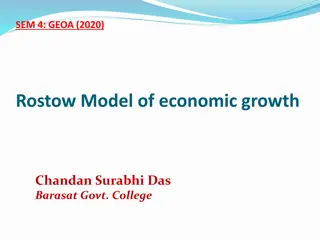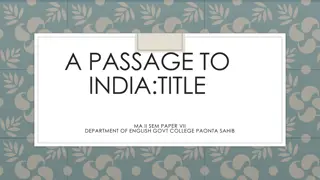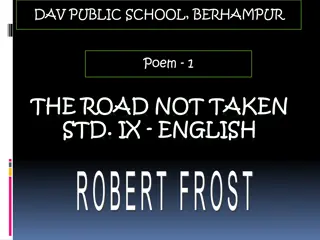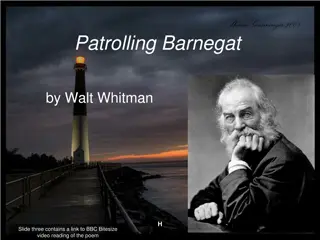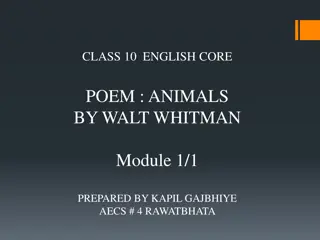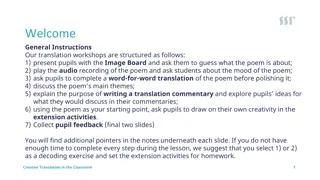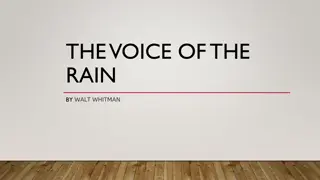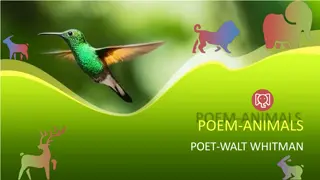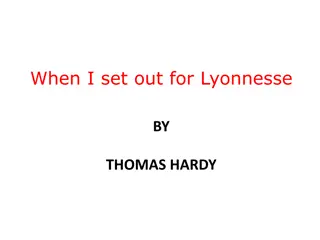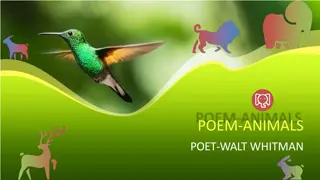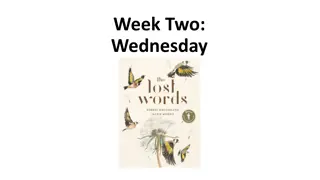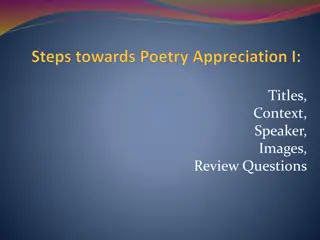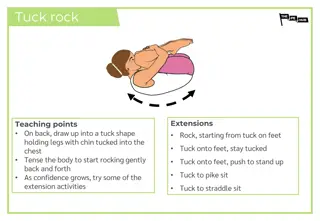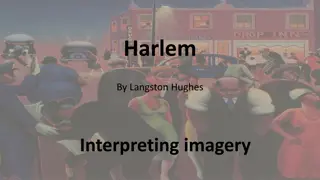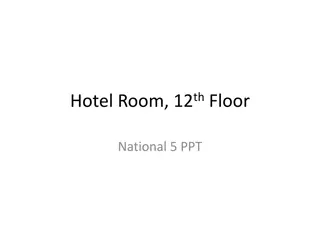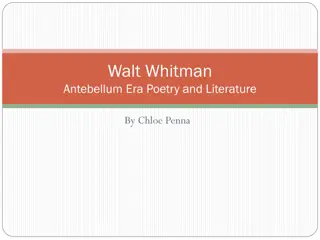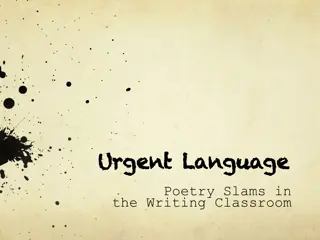Analysis of Walt Whitman's Poem "Out of the Cradle Endlessly Rocking
Walt Whitman's poem "Out of the Cradle Endlessly Rocking" explores themes of life, death, unity, and individuality through the speaker's childhood memories. The poem delves into the discovery of the secrets of life and death by the speaker as a child, focusing on a pair of birds and the male bird's grief upon losing his mate. This poignant narrative leads the speaker to contemplate existential questions and the cycle of life, depicting the powerful impact of nature on human emotions.
Download Presentation

Please find below an Image/Link to download the presentation.
The content on the website is provided AS IS for your information and personal use only. It may not be sold, licensed, or shared on other websites without obtaining consent from the author. Download presentation by click this link. If you encounter any issues during the download, it is possible that the publisher has removed the file from their server.
E N D
Presentation Transcript
A.J. SALEEMA KATHOON ASSISTANT PROFESSOR OF ENGLISH H.K.R.H. COLLEGE UTHAMAPALAYAM.
This poem was first published under the title "A Child's Reminiscence" (1859), was later called "A Word out of the Sea" (1860), and the present, highly symbolic title was given it in 1871. The present title suggests "a word from the sea," and that word is death, which is the second phase in the process of birthdeath- rebirth.
Out of the Cradle Endlessly Rocking was written by Walt Whitman, a great American poet. Out of a Cradle Endlessly Rocking is a superb literary piece about life, death, unity, and individuality. It was first published in 1871 in New York Saturday Press. The poem speaks about the speaker s childhood memories and the moment he decided to be a poet. It also illustrates how his early experiences shaped his life.
Composed of 35 stanzas, 208 lines. Written in free- verse Stanza's with regular format are Whitman's memories Stanza's with italics are the translation of the birds song (narration) First stanza sets the tone and establishes the setting from Whitman's memory Rest of the poem is the "story," or memory of Whitman's childhood.
The poem begins when the speaker beckons to the seashore at night pushed by a variety of forces. He remembers how, as a child, he discovered the secrets of life and death. At first, he talks about his carefree days as a boy, and later describes the time when he found a pair of birds who were singing their joyous song. He begins to understand their language and feelings. After some days, the poet discovered that the female bird has died, leaving the male bird in a state of despair.
Since their joyous union touched him, he can interpret the lonely call of the male bird. He tries to explain the bird s love in terms of the soliloquy of lost love. The bird s melancholic tone not only touches his heart but also enables him to experience the pain of loss. Now, the carefree narrator is changed: his heavy heart is desperate to know his own destiny upon which the ocean replies only with death.
Cycle of life, individuality, unity, and nature are the major themes underlined in this poem. The poem presents two things; the speaker s meaningful transformation from an immature child to a mature poet, and the transience of life. Through the images of tiny creatures, the speaker reflects on the secrets of life and death. Life, no matter how enchanting and vibrant, has to come to an end. Every living creature has to taste death.
The theme of love is also established in the mutual love of mockingbirds. The sensitive boy translates their emotions into human words and human emotions to establish the fact that everything in the universe follows the cycle of nature. Like humans, other creatures also lament the loss of their loved ones.
Literary devices are tools that enable the writers to enhance simple texts with multiple meanings. Their appropriate use helps the readers understand the latent meanings of the text. Walt Whitman has also employed some literary devices in this poem to bring depth to his text. The analysis of some of the literary devices used in this poem is given below.
Anaphora: It refers to the repetition of a word or expression in the first part of some verses. Whitman has repeated the words Out of the in the first stanza of the poem to emphasize the point. For example, Out of the cradle endlessly rocking, Out of the mockingbird s throat, the musical shuttle, Out of the Ninth-month midnight.
Assonance is the repetition of vowel sounds in the same line. For example, the sound of /i/ in twittering, rising, or overhead passing and the sound of /ai/ in Shine! shine! shine!.
Alliteration is the repetition of consonant sounds in the same line in quick succession. The poem has plenty of alliterations. For example, such as the sound of /d/ in For more than once dimly down to the beach gliding, and the sound of /m/ in But my mate no more, no more with me!
Imagery is used to make readers perceive things involving their five senses. For example, Are you whispering it, and have been all the time, you sea-waves? , A man, yet by these tears a little boy again and As a flock, twittering, rising, or overhead passing.
Personification is to give human qualities to inanimate objects. The poet has used this device at many places in the poem. For example, Over the hoarse surging of the sea , That strong and delicious word which, creeping to my feet and The sea whisper d me.
Rhetorical question is a question that is not asked in order to receive an answer; it is just posed to make the point clear and emphasize a point. For example, O night! do I not see my love fluttering out among the breakers? and What is that dusky spot in your brown yellow??
Symbolism is using symbols to signify ideas and qualities, giving them symbolic meanings that are different from the literal meanings. Sea symbolizes the spiritual and the imaginary world of poetry.
Poetic and literary devices are the same, but a few are used only in poetry. Here is the analysis of some of the poetic devices used in this poem. Free Verse: Free Verse is a type of poetry that does not contain patterns of rhyme or meter. This is a free-verse poem with no strict rhyme scheme or metrical pattern. Stanza: A stanza is a poetic form of some lines. There are thirty-two stanzas in this poem, with each having different numbers of verses in it.
The lines stated below are useful for lovers to reflect the meaning of their relationship. Two together! Winds blow south, or winds blow north, Day come white, or night come black, Home, or rivers and mountains from home, Singing all time, minding no time, While we two keep together.
Use of italics present during "aria" which is the bird's singing throughout the poem. The purpose of rhetorical questions is Whitman's intention to expand the reader's knowledge . Makes a point rather than demanding an actual answer. Example: "Is it indeed toward your mate you sing? or is it really to me?" (stanza 28)
Symbolic scenery in poem defines who he is and deepens the affect of the reader's emotions. The sun and the moon, the land and the sea, the stars and the sea waves. The use of repetition with vocabulary describing the sea and/or nature reflect Whitman's specific technique of figuratively conveying his specific message beyond the poem THE SEA: The sea is who he asks. The Sea is Mother Nature. Represents life and death. " Death, death, death, death, death" (197)
http://www.poetryfoundation.org/poem/178 710 ( Poem) http://www.english.illinois.edu/maps/poets/ s_z/whitman/cradle.htm Writers and critics gave their own opinions on what the poem meant through the use of xx devices and type of structure,etc. http://www.whitmanarchive.org/criticism/c urrent/encyclopedia/entry_43.html




